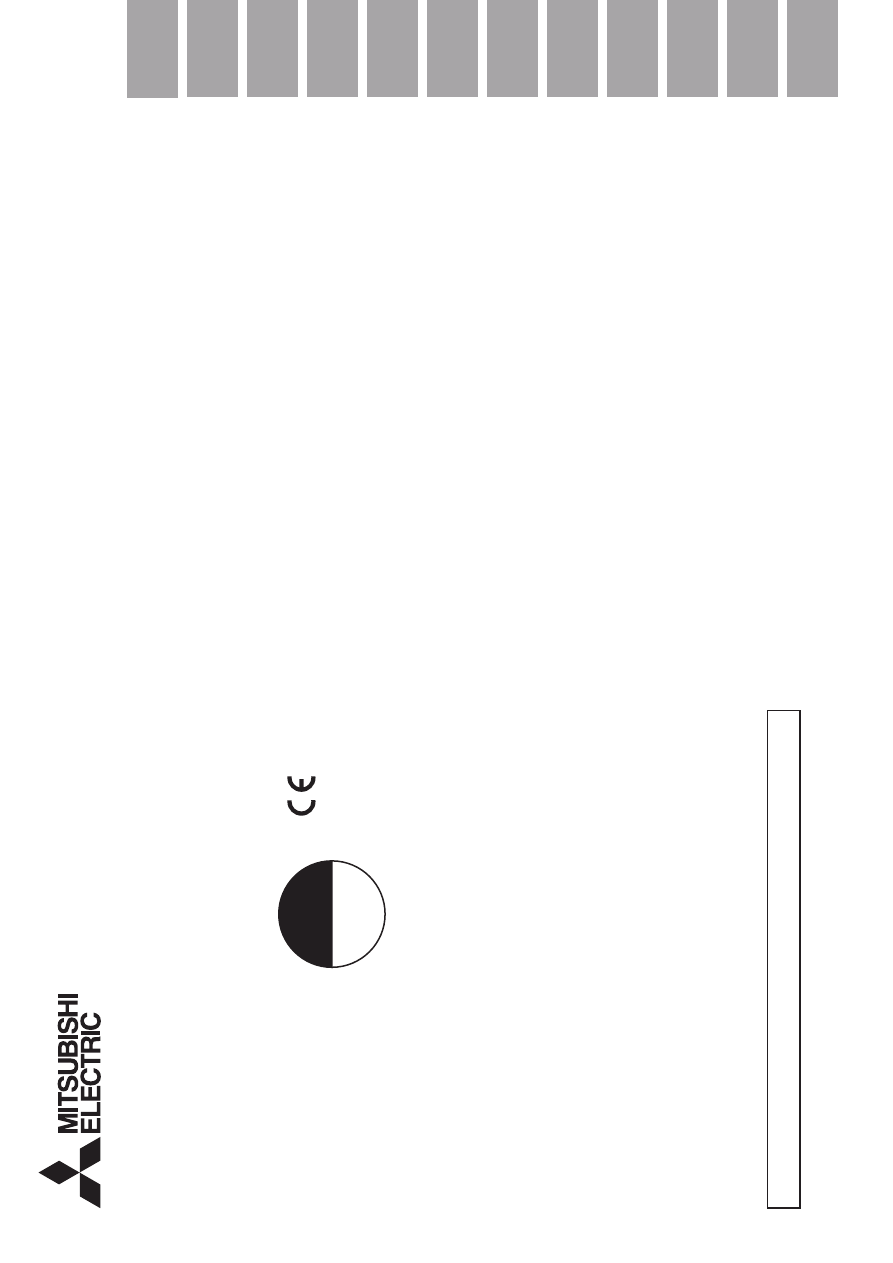
Русский
Refer
to
the
installation
manual
of
each
indoor
unit
for
indoor
unit
installation.
IN
S
T
A
L
L
A
T
IO
N
M
A
N
U
A
L
FOR
INST
ALLER
CONTENTS
1.
THE
FOLLOWING
SHOULD
AL
W
A
YS
BE
OBSER
VED
FOR
SAFETY
...........................................................................................
2
2.
INST
ALLA
TION
DIAGRAM
&
ACCESSORIES
................................
2
3.
SELECTING
THE
INST
ALLA
TION
LOCA
TION
................................
3
4.
OUTDOOR
UNIT
INST
ALLA
TION
...................................................
4
5.
INDOOR/OUTDOOR
UNITS
CONNECTION
FINISHING
AND
TEST
RUN
.......................................................................................
6
English
D
e
u
ts
c
h
F
ra
n
ç
a
is
N
e
d
e
rl
a
n
d
s
E
s
p
a
ñ
o
l
It
a
lia
n
o
∂
Ï
Ï
Ë
Ó
ÈÎ
¿
P
o
rt
u
g
u
ê
s
D
a
n
s
k
S
v
e
n
s
k
a
T
ü
rk
ç
e
SPLIT
-TYPE
AIR
CONDITIONER
M
o
d
e
l
M
X
Z
-4
A
8
0
V
A
HFC
utiliz
ed
R410A
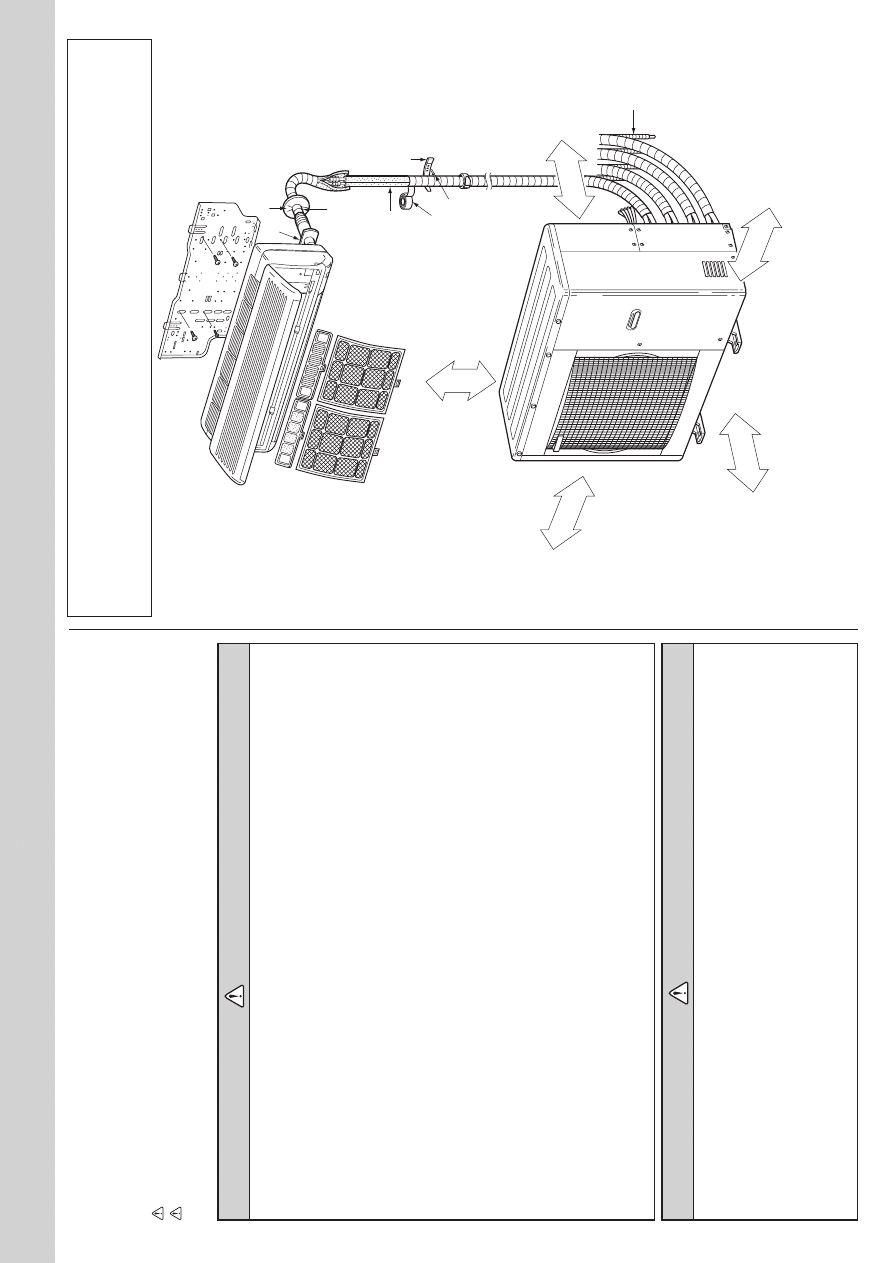
2
K
H
F
I
J
E
C
D
2
.
IN
S
T
A
L
L
A
T
IO
N
D
IA
G
R
A
M
&
A
C
C
E
S
S
O
R
IE
S
1
.
T
H
E
F
O
L
L
O
W
IN
G
S
H
O
U
L
D
A
L
W
A
Y
S
B
E
O
B
S
E
R
V
E
D
F
O
R
S
A
F
E
T
Y
•
Please
provide
an
exclusive
circuit
for
the
air
conditioner
and
make
sure
that
no
other
electrical
appliances
are
connected
to
it.
•
Be
sure
to
read
“THE
FOLLOWING
SHOULD
AL
W
A
YS
BE
OBSER
VED
FOR
SAFETY”
before
install-
ing
the
air
conditioner
.
•
Be sure to observe the cautions specified here as they include important items related to safety
.
•
The
indications
and
meanings
are
as
follows.
W
ARNING:
Could
lead
to
death,
serious
injury
,
etc.
CAUTION:
Could lead to serious injury in particular environments when operated incorrectly
.
•
After
reading
this
manual,
be
sure
to
keep
it
together
with
the
OPERA
TING
INSTRUCTIONS
in
a
handy
place
on
the
customer
’s
site.
W
A
R
N
IN
G
■
Do
not
install
the
unit
by
yourself
(customer).
Incomplete
installation
could
cause
injury
due
to
fire,
electric
shock,
the
unit
falling
or
leakage
of
water
.
Consult
the
dealer
from
whom
you
pur-
chased
the
unit
or
special
installer
.
■
Install
the
unit
securely
in
a
place
which
can
bear
the
weight
of
the
unit.
W
h
e
n
in
s
ta
lle
d
in
a
n
in
s
u
ff
ic
ie
n
t
s
tr
o
n
g
p
la
c
e
,
th
e
unit
could
fall
causing
injury
.
■
Use
the
specified
wires
to
connect
the
indoor
a
n
d
o
u
td
o
o
r
u
n
it
s
s
e
c
u
re
ly
a
n
d
a
tt
a
c
h
t
h
e
wires
firmly
to
the
terminal
block
connecting
sections
so
the
stress
of
the
wires
is
not
ap-
plied
to
the
sections.
In
c
o
m
p
le
te
c
o
n
n
e
c
tin
g
a
n
d
fi
x
in
g
c
o
u
ld
c
a
u
s
e
fi
re
.
■
D
o
n
o
t
u
s
e
i
n
te
rm
e
d
ia
te
c
o
n
n
e
c
ti
o
n
o
f
th
e
power
cord
or
the
extension
cord
and
do
not
connect
many
devices
to
one
AC
outlet.
It
c
o
u
ld
c
a
u
s
e
a
f
ir
e
o
r
a
n
e
le
c
tr
ic
s
h
o
c
k
d
u
e
t
o
d
e
-
fe
c
tiv
e
c
o
n
ta
c
t,
d
e
fe
c
tiv
e
in
s
u
la
tio
n
,
e
x
c
e
e
d
in
g
t
h
e
p
e
rm
is
s
ib
le
c
u
rr
e
n
t,
e
tc
.
■
Check
that
the
refrigerant
gas
due
not
leak
after
installation
has
completed.
If
refrigerant
gas
leaks
indoors,
and
comes
into
c
o
n
ta
c
t
w
it
h
t
h
e
f
ir
e
o
f
a
f
a
n
h
e
a
te
r,
s
p
a
c
e
h
e
a
te
r,
s
to
v
e
, e
tc
.,
h
a
rm
fu
l s
u
b
s
ta
n
c
e
s
w
ill
b
e
g
e
n
e
ra
te
d
.
■
Perform
the
installation
securely
referring
to
the
installation
manual.
Incomplete
installation
could
cause
a
personal
injury
due
to
fire,
electric
shock,
the
unit
falling
or
leakage
of
water
.
■
Perform
electrical
work
according
to
the
in-
stallation
manual
and
be
sure
to
use
an
ex-
clusive
circuit.
If
the
capacity
of
the
power
circuit
is
insuf
ficient
or
there
is
insuf
ficient
electrical
work,
it
could
re-
sult
in
a
fire
or
an
electric
shock.
■
A
tt
a
c
h
t
h
e
e
le
c
tr
ic
a
l c
o
v
e
r
to
t
h
e
in
d
o
o
r
u
n
it
a
n
d
th
e
s
e
rv
ic
e
p
a
n
e
l
to
t
h
e
o
u
td
o
o
r
u
n
it
s
e
c
u
re
ly
.
If
the
electrical
cover
in
the
indoor
unit
and/or
the
s
e
rv
ic
e
p
a
n
e
l i
n
t
h
e
o
u
td
o
o
r
u
n
it
a
re
n
o
t
a
tt
a
c
h
e
d
s
e
c
u
re
ly
,
it
c
o
u
ld
r
e
s
u
lt
i
n
a
f
ir
e
o
r
a
n
e
le
c
tr
ic
shock
due
to
dust
water
,
etc.
■
Be
sure
to
use
the
part
provided
or
specified
parts
for
the
installation
work.
The
use
of
defective
parts
could
cause
an
injury
due
to
a
fire,
an
electric
shock,
the
unit
falling,
leakage
of
water
,
etc.
■
Be
sure
to
cut
off
the
main
power
in
case
of
setting
up
the
indoor
electronic
control
P
.C.
board
or
wiring
works.
It
could
cause
an
electric
shock.
■
T
h
e
a
p
p
li
a
n
c
e
s
h
a
ll
b
e
in
s
ta
ll
e
d
in
a
c
c
o
rd
a
n
c
e
with
national
wiring
regulations.
■
When
installing
or
relocating
the
unit,
make
sure
that
no
substance
other
than
the
speci-
fi
e
d
r
e
fr
ig
e
ra
n
t
(R
4
1
0
A
)
e
n
te
rs
t
h
e
r
e
fr
ig
e
ra
n
t
c
ir
c
u
it
.
Any
presence
of
foreign
substance
such
as
air
can
cause
abnormal
pressure
rise
or
an
explo-
sion.
More
than
100
mm
Open
as
a
rule
More
than
500
mm
if
t
h
e
f
ro
n
t
a
n
d
b
o
th
sides
are
open
M
o
re
t
h
a
n
1
0
0
m
m
M
o
re
t
h
a
n
2
0
0
m
m
i
f
th
e
re
a
re
o
b
s
ta
c
le
s
t
o
b
o
th
s
id
e
s
Open
as
a
rule
More
than
500
mm
if
the
back,
both
sides
and
top
are
open
More
than
350
mm
N
o
te
:
The
dimensions
given
along
the
arrows
above
are
required
to
guarantee
the
air
conditioner
’s
performance.
Install
the
unit
in
as
wide
a
place
as
possible
for
later
service
or
repairs.
Before
installation
This
installation
manual
is
only
for
the
outdoor
unit
installation.
In
installing
the
indoor
units,
refer
to
the
installation
manual
attached
to
each
indoor
unit.
Any
structural
alternations
necessary
for
the
installation
must
comply
with
the
local
building
code
require-
m
e
n
ts
.
CAUTION
■
Perform
earthing.
D
o
n
o
t
c
o
n
n
e
c
t
th
e
e
a
rt
h
w
ir
e
t
o
a
g
a
s
p
ip
e
,
w
a
te
r
p
ip
e
,
lig
h
tn
in
g
r
o
d
o
r
te
le
p
h
o
n
e
e
a
rt
h
w
ir
e
.
D
e
fe
c
-
ti
v
e
e
a
rt
h
in
g
c
o
u
ld
c
a
u
s
e
a
n
e
le
c
tr
ic
s
h
o
c
k
.
■
Do
not
install
the
unit
in
a
place
where
an
in-
flammable
gas
leaks.
If
gas
leak
and
accumulate
in
the
area
surround-
ing
the
unit,
it
could
cause
an
explosion.
■
F
a
s
te
n
a
f
la
re
n
u
t
w
it
h
a
t
o
rq
u
e
w
re
n
c
h
a
s
specified
in
this
manual.
W
h
e
n
fa
st
e
n
e
d
to
o
ti
g
h
t,
a
fl
a
re
n
u
t m
a
y
b
ro
ke
n
a
ft
e
r
a
lo
n
g
p
e
ri
o
d
a
n
d
c
a
u
se
a
le
a
ka
g
e
o
f
re
fr
ig
e
ra
n
t.
■
In
s
ta
ll
a
n
e
a
rt
h
l
e
a
k
a
g
e
b
re
a
k
e
r
d
e
p
e
n
d
in
g
on
the
installation
place
(Where
it
is
humid).
If
a
e
a
rt
h
le
a
k
a
g
e
b
re
a
k
e
r
is
n
o
t
in
s
ta
lle
d
,
it
c
o
u
ld
cause
an
electric
shock.
■
P
e
rf
o
rm
t
h
e
d
ra
in
a
g
e
/p
ip
in
g
w
o
rk
s
e
c
u
re
ly
according
to
the
installation
manual.
If
there
is
a
defect
in
the
drainage/piping
work,
water
could
drop
from
the
unit
and
household
goods
could
be
wet
and
damaged.
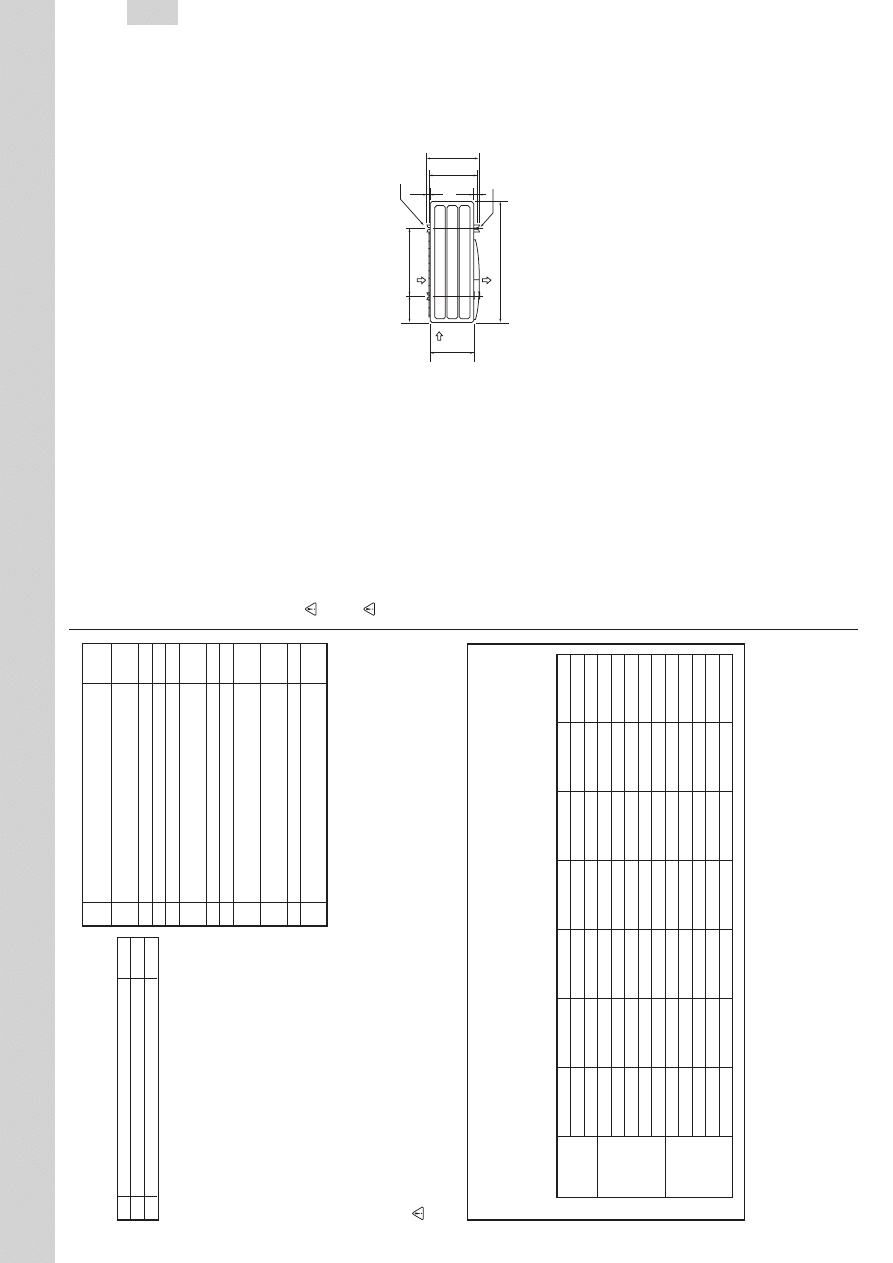
3
A
C
C
E
S
S
O
R
IE
S
Check
the
following
parts
before
installation.
<Outdoor
unit>
1
Drain
socket
1
2
Drain
cap
2
3
QUICK
CLEAN
KIT
1
Parts
to
be
locally
procured
A
Power
supply
cord
1
(3-core
2.5
mm
2
)
B
Indoor/outdoor
unit
connecting
wire
1
(4-core
1.0
mm
2
/1.5
mm
2
)
C
Extension
pipe
According
to
“Selecting
pipe
size”
1
D
W
all
hole
cover
1
E
Piping
tape
1
F
E
xt
e
n
si
o
n
d
ra
in
h
o
se
(
o
r
so
ft
vi
n
yl
c
h
lo
rid
e
h
o
se
o
f
1
15
mm
in
internal
dia.
or
hard
vinyl
chloride
pipe
VP16)
G
Refrigeration
oil
Little
amount
H
P
u
tt
y
1
I
Pipe
fixing
band
2
to
7
(The
number
depends
on
the
pipe
length.)
J
Fixing
screw
for
I
2
to
7
(The
number
depends
on
the
pipe
length.)
K
W
all
hole
sleeve
1
L
Soft
vinyl
chloride
hose
of
25
mm
in
internal
1
dia.
or
hard
vinyl
chloride
pipe
VP25
N
O
T
E
:
•••••
Do
not
use
the
drain
socket
and
the
drain
cap
in
the
cold
region.
Drain
may
freeze
and
it
makes
the
fan
stop.
•
The
“Q’ty”
for
B
to
K
in
the
above
table
is
the
quantity
to
be
used
per
indoor
unit.
W
A
R
N
IN
G
:
Be
sure
to
use
specified
accessories
and
supplied
parts
for
installation
work.
If
there
is
some
defi-
ciency
in
parts,
it
may
cause
a
risk
of
fire,
electric
shock,
injury
by
a
unit
fall
or
water
leakage.
3.
SELECTING
THE
INST
ALLA
TION
LOCA
TION
•
Where
it
is
not
exposed
to
strong
wind.
•
Where
airflow
is
good
and
dustless.
•
Where
it
is
not
exposed
to
rain
and
direct
sunshine.
•
Where
neighbours
are
not
annoyed
by
operation
sound
or
hot
air
.
•
Where
rigid
wall
or
support
is
available
to
prevent
the
increase
of
operation
sound
or
vibration.
•
Where
there
is
no
risk
of
combustible
gas
leakage.
•
When
installing
the
unit
at
a
high
level,
be
sure
to
fix
the
unit
legs.
•
Where
it
is
at
least
3
m
away
from
the
antenna
of
TV
set
or
radio.
Operation
of
the
air
conditioner
may
interfere
with
radio
or
TV
reception
in
areas
where
reception
is
weak.
An
amplifier
may
be
required
for
the
af
fected
device.
•
Install
the
unit
horizontally
.
•
Please
install
it
in
an
area
not
af
fected
by
snowfall
or
blowing
snow
.
In
areas
with
heavy
snow
,
please
install
a
canopy
,
a
pedestal
and/or
some
baf
fle
boards.
N
o
te
:
It
is
advisable
to
make
a
piping
loop
near
outdoor
unit
so
as
to
reduce
vibration
transmitted
from
there.
W
ARNING:
Be
sure
to
install
the
unit
in
a
place
that
well
sustains
its
weight.
Installing in a place with less strength may result in a unit falling, causing a risk of injury
.
C
A
U
T
IO
N
:
A
void
the
following
places
for
installation
where
air
conditioner
trouble
is
liable
to
occur
.
•••••
Where
flammable
gas
could
leak.
•••••
Where
there
is
much
machine
oil.
•••••
Salty
places
such
as
the
seaside.
•••••
Where
sulfide
gas
is
generated
such
as
a hot spring.
•••••
Where
there
is
high-frequency
or
wire-
less
equipment.
N
o
te
:
When
operating
the
air
conditioner
in
low
outside
temperature,
be
sure
to
follow
the
instructions
de-
scribed
below
.
•••••
Never
install
the
outdoor
unit
in
a
place
where
its
air
inlet/outlet
side
may
be
exposed
directly
to
w
in
d
.
•••••
T
o
prevent
exposure
to
wind,
install
the
outdoor
unit
with
its
air
inlet
side
facing
the
wall.
•••••
T
o
prevent
exposure
to
wind,
it
is
recommended
to
install
a
baffle
board
on
the
air
outlet
side
of
the
outdoor
unit.
Constraints On Indoor Unit Installation
Y
ou
should
note
that
indoor
unit
that
can
be
connected
to
this
outdoor
unit
have
the
following
constraints
on
th
e
m
.
•
Indoor
units
with
model
numbers
22,
25,
35,
50,
60
and
71
can
be
connected.
Refer
to
the
table
below
for
possible
two-room,
three-room
and
four-room
indoor
unit
combinations.
200
387
355
27
40
500
900
320
Air
in
Air
out
Air in
2-U-shape
notched
holes
(Base
bolt
M10)
2-12
×
36
Oval
holes
(Base
bolt
M10)
(Unit:
mm)
2
2
+
2
2
2
2
+
2
5
2
2
+
3
5
2
2
+
5
0
2
2
+
6
0
2
2
+
7
1
2
5
+
2
5
2
U
N
IT
2
5
+
3
5
2
5
+
5
0
2
5
+
6
0
2
5
+
7
1
3
5
+
3
5
3
5
+
5
0
3
5
+
6
0
3
5
+
7
1
5
0
+
5
0
5
0
+
6
0
5
0
+
7
1
6
0
+
6
0
6
0
+
7
1
2
2
+
2
2
+
2
2
2
2
+
2
2
+
2
5
2
2
+
2
2
+
3
5
2
2
+
2
2
+
5
0
2
2
+
2
2
+
6
0
2
2
+
2
2
+
7
1
2
2
+
2
5
+
2
5
2
2
+
2
5
+
3
5
2
2
+
2
5
+
5
0
2
2
+
2
5
+
6
0
2
2
+
2
5
+
7
1
2
2
+
3
5
+
3
5
2
2
+
3
5
+
5
0
2
2
+
3
5
+
6
0
3
U
N
IT
2
2
+
3
5
+
7
1
2
2
+
5
0
+
5
0
2
2
+
5
0
+
6
0
2
2
+
5
0
+
7
1
2
5
+
2
5
+
2
5
2
5
+
2
5
+
3
5
2
5
+
2
5
+
5
0
2
5
+
2
5
+
6
0
2
5
+
2
5
+
7
1
2
5
+
3
5
+
3
5
2
5
+
3
5
+
5
0
2
5
+
3
5
+
6
0
2
5
+
3
5
+
7
1
2
5
+
5
0
+
5
0
2
5
+
5
0
+
6
0
3
5
+
3
5
+
3
5
3
5
+
3
5
+
5
0
3
5
+
3
5
+
6
0
3
5
+
3
5
+
7
1
3
5
+
5
0
+
5
0
3
5
+
5
0
+
6
0
2
2
+
2
2
+
2
2
+
2
2
2
2
+
2
2
+
2
2
+
2
5
2
2
+
2
2
+
2
2
+
3
5
2
2
+
2
2
+
2
2
+
5
0
2
2
+
2
2
+
2
2
+
6
0
2
2
+
2
2
+
2
2
+
7
1
2
2
+
2
2
+
2
5
+
2
5
2
2
+
2
2
+
2
5
+
3
5
2
2
+
2
2
+
2
5
+
5
0
2
2
+
2
2
+
2
5
+
6
0
2
2
+
2
2
+
2
5
+
7
1
2
2
+
2
2
+
3
5
+
3
5
2
2
+
2
2
+
3
5
+
5
0
2
2
+
2
2
+
3
5
+
6
0
4
U
N
IT
2
2
+
2
2
+
5
0
+
5
0
2
2
+
2
5
+
2
5
+
2
5
2
2
+
2
5
+
2
5
+
3
5
2
2
+
2
5
+
2
5
+
5
0
2
2
+
2
5
+
2
5
+
6
0
2
2
+
2
5
+
3
5
+
3
5
2
2
+
2
5
+
3
5
+
5
0
2
2
+
2
5
+
3
5
+
6
0
2
2
+
3
5
+
3
5
+
3
5
2
2
+
3
5
+
3
5
+
5
0
2
5
+
2
5
+
2
5
+
2
5
2
5
+
2
5
+
2
5
+
3
5
2
5
+
2
5
+
2
5
+
5
0
2
5
+
2
5
+
2
5
+
6
0
2
5
+
2
5
+
3
5
+
3
5
2
5
+
2
5
+
3
5
+
5
0
2
5
+
3
5
+
3
5
+
3
5
3
5
+
3
5
+
3
5
+
3
5
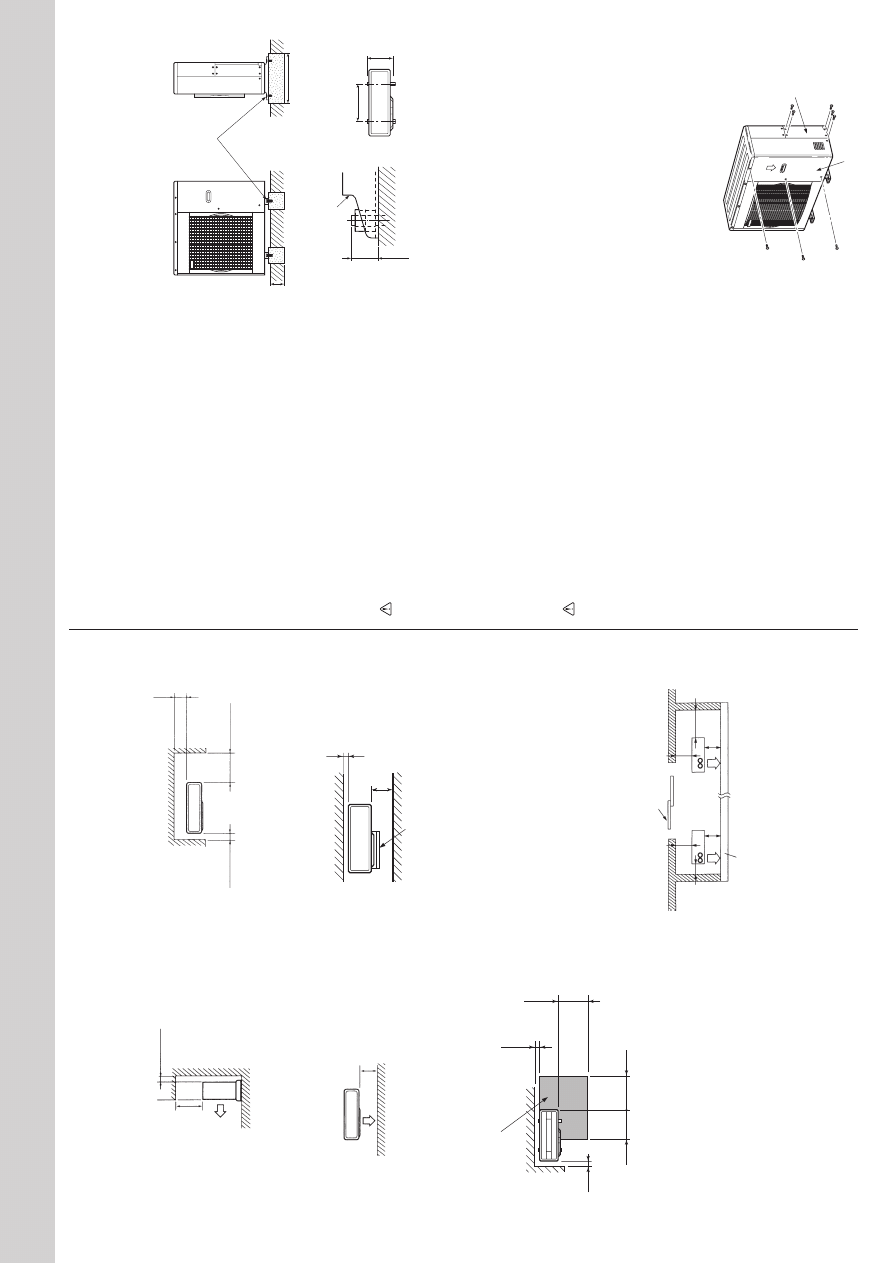
4
4.
OUTDOOR
UNIT
INST
ALLA
TION
4-1
INST
ALLING
THE
UNIT
•
Be
sure
to
fix
the
unit
’s
legs
with
bolts
when
installing
it.
•
Be
sure
to
install
the
unit
firmly
to
ensure
that
it
does
not
fall
by
an
earthquake
or
a
gust.
•
Refer
to
the
figure
in
the
right
for
concrete
foundation.
N
o
te
:
The
length
of
anchor
bolts
should
be
within
25
mm
from
each
anchor
leg.
•
Do
not
use
the
drain
socket
and
the
drain
cap
in
the
cold
re
g
io
n
.
Drain
may
freeze
and
it
makes
the
fan
stop.
C
A
U
T
IO
N
:
Be
sure
to
carry
out
drain
piping
work
following
the
in-
stallation
manual.
If
there
is
some
deficiency
in
draining
and
piping
work,
it
may
cause
a
risk
of
dripping
from
the
unit,
wetting
or
forling
your
property
.
4-2
MOUNTING
ARRANGEMENT
OF
DRAIN
SOCKET
Please
perform
the
drain
piping
work
only
when
draining
from
one
place.
C
A
U
T
IO
N
:
Do
not
use
drain
socket
and
drain
cap
in
the
cold
region.
Drain
may
freeze
and
it
makes
the
fan
stop.
1
Please
choose
one
hole
to
discharge
drain
and
install
the
drain
socket
to
the
hole.
2
Please close the rest of the holes with the drain caps.
3
P
le
a
s
e
c
o
n
n
e
c
t a
v
in
y
l h
o
s
e
o
f 2
5
m
m
in
th
e
in
s
id
e
d
ia
m
e
te
r
o
n
th
e
m
a
rk
e
t w
it
h
th
e
d
ra
in
s
o
c
k
e
t a
n
d
le
a
d
d
ra
in
.
4
-3
H
O
W
T
O
R
E
M
O
V
E
T
H
E
S
E
R
V
IC
E
P
A
N
E
L
A
N
D
T
H
E
C
O
N
N
E
C
T
C
O
V
E
R
•
Remove
the
four
service
panel
securing
screws,
and
pull
the
panel
down
in
an
arrow
direction
to
remove
the
service
p
a
n
e
l.
•
R
e
m
o
v
e
th
e
fo
u
r
c
o
n
n
e
c
t c
o
v
e
r
s
e
c
u
ri
n
g
s
c
re
w
s
to
r
e
m
o
v
e
the
connect
cover
.
FREE
SP
ACE
REQUIRED
AROUND
OUTDOOR
UNIT
(Unit:
mm)
500 or more
100 or more
200 or more
350 or more
100 or more
500 or more
1
.
T
o
p
s
id
e
o
b
s
ta
c
le
s
W
h
e
n
th
e
re
is
a
n
o
b
s
ta
c
le
b
e
h
in
d
th
e
r
e
a
r
s
id
e
o
n
ly
,
it
does
not
matter
if
there
is
an
obstacle
over
the
top
side
as
shown
in
the
figure
below
.
2
.
F
ro
n
t
(b
lo
w
in
g
)
s
id
e
o
p
e
n
As
long
as
space
like
the
one
shown
in
the
figure
can
be
maintained,
it
does
not
matter
if
there
are
obstacles
in
three
directions
(but
top
side
is
open).
3
.
O
b
s
ta
c
le
s
o
n
f
ro
n
t
(b
lo
w
in
g
)
s
id
e
o
n
ly
In
this
case,
the
rear
,
both
sides
and
top
should
be
o
p
e
n
.
4
.
O
b
s
ta
c
le
s
o
n
f
ro
n
t
a
n
d
r
e
a
r
s
id
e
o
n
ly
The
unit
can
be
used
by
attaching
an
optional
out-
door
blowing
guide
(MAC-855SG)
(but
both
sides
and
top
are
open).
100 or more
500 or more
Blowing
guide
(MAC-855SG)
100 or more
500 or more
100 or more
Service
space
350 or more
500 or more
;;;;
;;;;
5
.
S
e
rv
ic
e
s
p
a
c
e
Keep
the
service
space
as
shown
in
the
figure
be-
low
for
maintenance.
•
W
h
e
n
in
s
ta
lli
n
g
t
h
e
u
n
it
in
a
n
a
re
a
t
h
a
t
is
e
n
c
lo
s
e
d
o
n
fo
u
r
s
id
e
s
s
u
c
h
a
s
a
v
e
ra
n
d
a
h
, b
e
s
u
re
to
le
a
v
e
move
than
200
mm
behind
the
unit
as
shown.
•
When
there
is
a
lack
of
airflow
or
there
is
a
possi-
b
ili
ty
o
f b
e
c
o
m
in
g
s
h
o
rt
c
y
c
le
, i
n
s
ta
ll
a
n
o
u
tle
t g
u
id
e
and
make
sure
there
is
enough
space
behind
the
rear
side
of
the
air
inlet.
N
o
te
:
Make
sure
not
to
install
several
outdoor
units
sideways
next
to
each
other
.
W
in
d
o
w
More
than
100
mm
L
e
s
s
t
h
a
n
1
,2
0
0
m
m
o
f
th
e
front
surface
side
More
than
200
mm
More
than
350
mm
More
than
200
mm
More
than
200
mm
500
330
Fix
here
with
M10
bolts.
Make
the
setting
depth
deeper
.
Make
with
wider
.
Anchor
leg
25 mm
or less
Anchor
both
length
Anchor
both
pitch
(Unit:
mm)
Service
panel
C
o
n
n
e
c
t
c
o
v
e
r
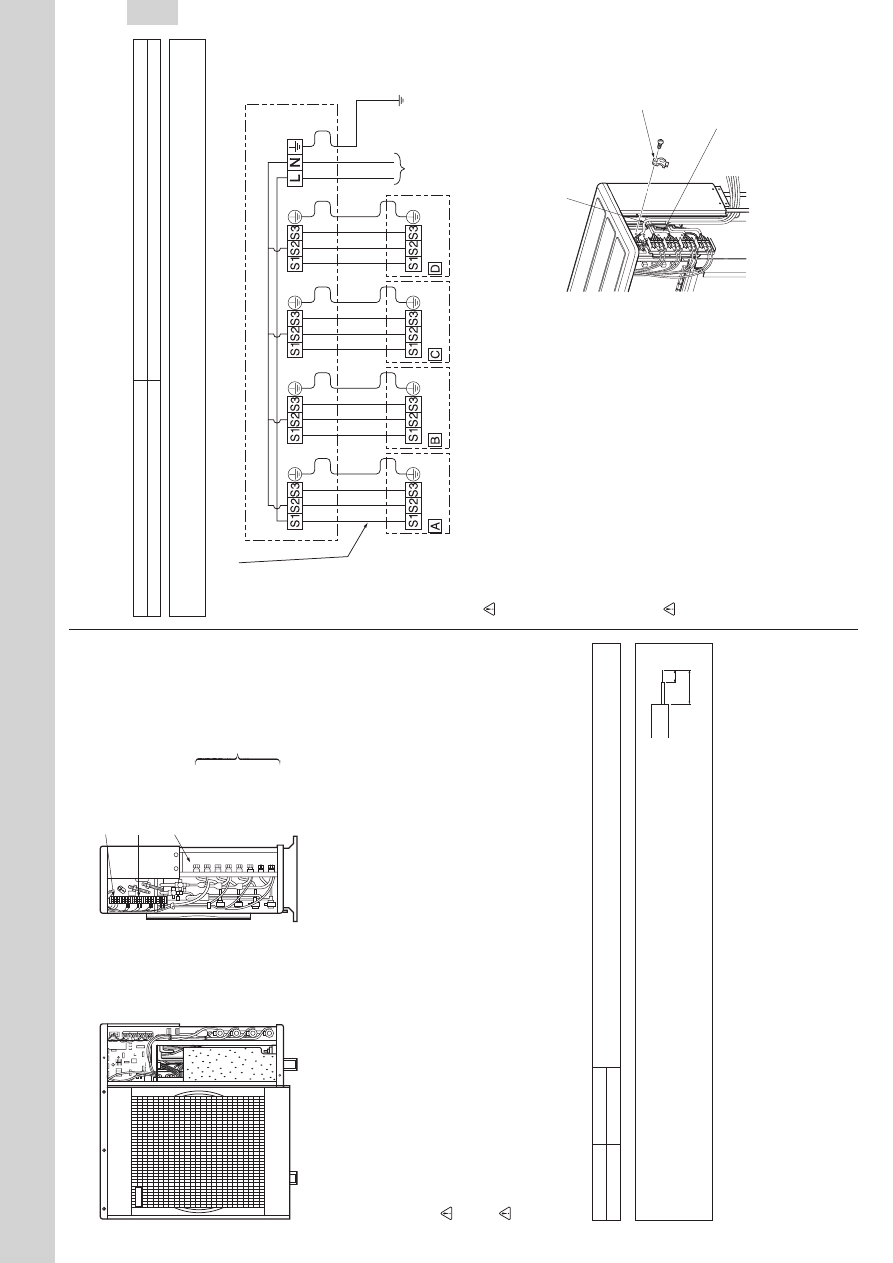
5
Connect
to
the
supply
terminals
and
leave
a
contact
separation
of
at
least
3
mm
at
each
pole
to
disconnect
the
source
power
pole.
(When
the
power
switch
is
shut
of
f,
it
must
disconnect
all
poles.)
<
F
ro
n
t
V
ie
w
>
<
R
ig
h
t
S
id
e
V
ie
w
>
35 mm
15 mm
Indoor/Outdoor unit
connecting
wire
B
Cable
clamp
Power
supply
cord
A
4-4
INDOOR/OUTDOOR
WIRE
CONNECTION
AND
OUTDOOR
POWER
SUPPL
Y
CORD
CONNECTION
•
Be
sure
to
lead
in
the
power
supply
cord
A
t
o
t
h
e
a
ir
c
o
n
d
it
io
n
e
r
in
a
c
c
o
rd
a
n
c
e
w
it
h
t
h
e
s
p
e
c
if
ic
a
ti
o
n
t
a
b
le
below
and
“T
echnical
Standards
for
Electrical
Installation
”.
•
Be
sure
to
use
special
circuits
for
room
air
conditioner
.
CAUTION:
Attach
an
earth
leakage
breaker
according
to
your
installation
location.
If
any
breaker
is
not
attached,
it
may
cause
a
risk
of
electric
shock.
W
A
R
N
IN
G
:
Be
sure
to
comply
with
“
T
echnical
Standards
for
Electrical
Installation
”
,
follow
this
manual
and
use
special
circuits
for
electrical
work.
If
there
is
a
lack
of
circuit
capacity
or
some
deficiency
in
installation,
it
may
cause
a
risk
of
fire
or
electric
shock.
Overcurrent
that
might
be
produced
may
include
DC
substances.
Be
careful
to
choose
the
correct
type
of
overcurrent
protection
switch.
Rated V
oltage
Breaker capacity
230
V
25
A
•
Peel
of
f
both
ends
of
the
cables
as
shown
in
the
right.
•
T
ake
care
not
to
let
the
cables
contact
the
pipes
inside
the
unit.
•
T
ake
enough
care
to
connect
the
indoor/outdoor
unit
connecting
wire
correctly
be-
tween
the
respective
indoor
units
and
the
outdoor
unit.
•
Make earth wire a little longer than the others. (more than 35 mm)
•
For
the
power
supply
cord
and
the
indoor/outdoor
unit
connecting
wires,
be
sure
to
use
the
ones
in
compli-
ance
with
the
standards.
•
Be
sure
to
push
the
core
until
it
is
hidden
and
pull
each
cable
to
make
sure
that
it
is
not
pulled
up.
Incomplete
insertion
may
cause
a
risk
of
burning
the
terminal
blocks.
Power
supply
cord
Specification
Cable
3-core
2.5
mm
2
, in conformity with Design 245 IEC 57.
Indoor
and
Outdoor
connecting
wire
Specification
Cable
4-core
1.0/1.5
mm
2
,
in
conformity
with
Design
245
IEC
57.
This
installation
manual
is
only
for
the
outdoor
unit
installation.
In
installing
the
indoor
units,
refer
to
the
installation
manual
attached
to
each
indoor
unit.
W
A
R
N
IN
G
:
Use
the
indoor/outdoor
unit
connecting
wire
that
meets
the
Standards
to
connect
the
indoor
and
out-
door
units
and
fix
the
wire
to
the
terminal
block
securely
so
that
no
external
force
is
conveyed
to
the
connecting
section
of
the
terminal
block.
Incomplete
connection
or
fixing
of
the
wire
could
result
in
a
fi
re
.
•
Give
extra
length
to
both
power
supply
cord
A
and
in-
door/outdoor
unit
connecting
wire
B
taking
later
service
into
account.
•
After
making
connections
between
both
power
supply
cord
A
and
indoor/outdoor
unit
connecting
wire
B
,
be
sure
to
fix
both
cable
and
wire
with
cable
clamps.
W
A
R
N
IN
G
:
Be
sure
to
attach
the
terminal
block
covers
(panel)
of
both
indoor
and
outdoor
units.
If
there
is
some
defi-
c
ie
n
c
y
in
t
e
rm
in
a
l b
lo
c
k
c
o
v
e
r
(p
a
n
e
l)
a
tt
a
c
h
m
e
n
t,
it
m
a
y
cause
a
risk
of
fire
or
electric
shock
due
to
dust
or
wa-
te
r.
Connection
pipe
connections
Power
cable
terminal
block
In
d
o
o
r/
O
u
td
o
o
r
c
o
n
n
e
c
ti
n
g
t
e
rm
in
a
l b
lo
c
k
Opening
for
power
cable
and
indoor/out-
door
connecting
wire
L
iq
u
id
Î
U
N
IT
G
A
S
L
iq
u
id
Ç
U
N
IT
G
A
S
L
iq
u
id
ı
U
N
IT
G
A
S
L
iq
u
id
Å
U
N
IT
G
A
S
Indoor/outdoor
unit
connecting
wire
<OUTDOOR
UNIT>
POWER
SUPPL
Y
~/N
230
V
50
Hz
U
N
IT
U
N
IT
U
N
IT
U
N
IT
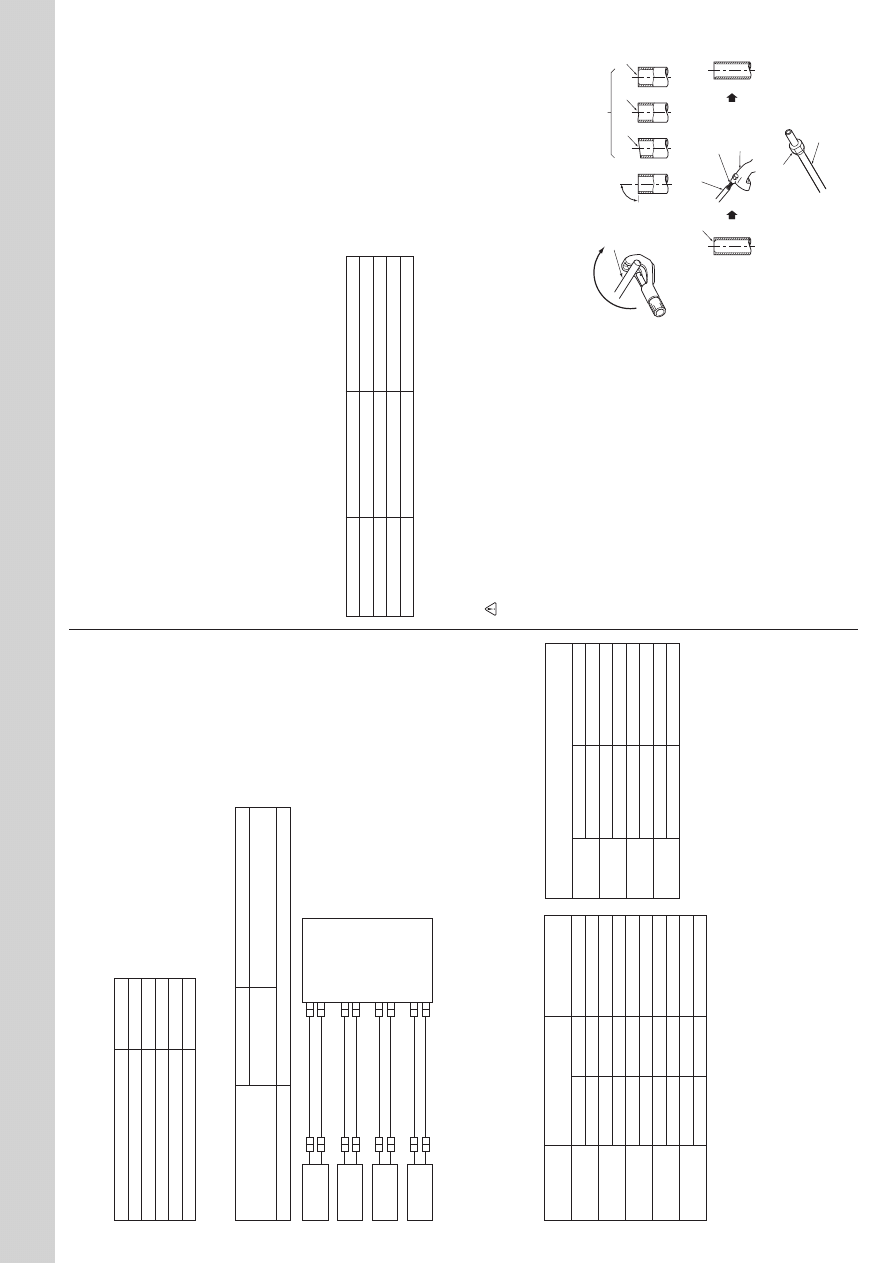
6
C
o
p
p
e
r
p
ip
e
G
o
o
d
No
good
T
ilt
e
d
U
n
e
v
e
n
B
u
rr
e
d
B
u
rr
Copper
pipe
S
p
a
re
re
a
m
e
r
Pipe
cutter
Flare
nut
Copper
pipe
5
-2
F
L
A
R
IN
G
W
O
R
K
•
Main
cause
of
gas
leakage
is
defect
in
flaring
work.
P
e
rf
o
rm
fl
a
ri
n
g
w
o
rk
c
o
rr
e
ct
ly
in
th
e
fo
llo
w
in
g
p
ro
ce
d
u
re
.
1
.
P
ip
e
c
u
tt
in
g
•
Cut
the
copper
pipe
correctly
with
pipe
cutter
.
2
.
B
u
rr
s
r
e
m
o
v
a
l
•
Completely
remove
all
burrs
from
the
cut
cross
section
of
the
pipe.
•
Put
the
end
of
the
copper
pipe
downward
to
pre-
vent
burrs
from
dropping
in
the
pipe.
3
.
P
u
tt
in
g
n
u
t
o
n
•
R
e
m
o
v
e
fl
a
re
n
u
ts
a
tt
a
c
h
e
d
to
in
d
o
o
r
a
n
d
o
u
td
o
o
r
units,
then
put
them
on
pipe
having
completed
burr
removal.
(not
possible
to
put
them
on
after
flaring
work)
•
F
la
re
n
u
t
fo
r
R
4
1
0
A
p
ip
e
m
a
y
d
if
fe
r
fr
o
m
R
2
2
p
ip
e
depending
on
the
diameter
of
pipe.
*
Connections
at
outdoor
unit
are
described
as
unit
A,
B,
C
and
D
below
corresponding
to
the
indica-
tion
on
each
valve.
•
If
the
diameter
of
connection
pipes
does
not
match
the
diameter
of
pipe
end
connections,
use
optional
dif
ferent-diameter
joints.
•
When
connecting
the
model
50
to
either
unit
B,
C
or
D,
use
optional
dif
ferent-diameter
joints
MAC-A454JP
because
the
valve
size
of
gas
pipes
for
the
outdoor
unit
is
ø
9.52
mm.
•
When
connecting
the
model
22,
25
or
35
to
unit
A,
use
optional
dif
ferent-diameter
joints
MAC-A455JP
be-
cause
the
valve
size
of
gas
pipes
for
the
outdoor
unit
is
ø
12.7
mm.
•
When
connecting
the
model
60
to
unit
A,
use
optional
dif
ferent-diameter
joints
MAC-A456JP
because
the
valve
size
of
gas
pipes
for
the
outdoor
unit
is
ø
12.7
mm.
•
When
connecting
the
model
60
to
either
unit
B,
C
or
D,
use
optional
dif
ferent-diameter
joints
P
AC-SG76RJ
because
the
valve
size
of
gas
pipes
for
the
outdoor
unit
is
ø
9.52
mm.
•
When
connecting
the
model
71
to
unit
A,
use
optional
dif
ferent-diameter
joints
MAC-A456JP
and
P
AC-493PI
because
the
valve
size
of
gas
pipe
and
liquid
pipe
for
the
outdoor
unit
is
ø
12.7
mm
and
ø
6.35
mm.
•
W
h
e
n
c
o
n
n
e
c
ti
n
g
t
h
e
m
o
d
e
l 7
1
t
o
e
it
h
e
r
u
n
it
B
,
C
o
r
D
,
u
s
e
o
p
ti
o
n
a
l d
iff
e
re
n
t-
d
ia
m
e
te
r
jo
in
ts
P
A
C
-S
G
7
6
R
J
a
n
d
P
A
C
-4
9
3
P
I
b
e
c
a
u
s
e
t
h
e
v
a
lv
e
s
iz
e
o
f
g
a
s
p
ip
e
a
n
d
li
q
u
id
p
ip
e
f
o
r
th
e
o
u
td
o
o
r
u
n
it
is
ø
9
.5
2
m
m
a
n
d
ø
6
.3
5
m
m
.
PIPING
PREP
ARA
TION
1
If
you
use
commercially
available
copper
pipes,
use
the
following
table
for
pipe
specifications.
Outside
diameter
W
all
thickness
Liquid
pipe
ø
6.35
mm
0.8
mm
Gas
pipe
ø
9.52
mm
0.8
mm
Gas
pipe
ø
12.7
mm
1.0
mm
Gas
pipe
ø
15.88
mm
1.0
mm
2
F
o
r
in
s
u
la
ti
o
n
m
a
te
ri
a
l,
u
s
e
8
m
m
-t
h
ic
k
h
e
a
t-
in
s
u
la
ti
n
g
e
x
p
e
n
d
e
d
p
o
ly
e
th
y
le
n
e
w
it
h
a
s
p
e
c
if
ic
g
ra
v
it
y
o
f
0
.0
4
5
.
3
Ensure
that
the
2
refrigerant
pipes
are
insulated
to
prevent
condensation.
4
Refrigerant
pipe
bending
radius
must
be
100
mm
or
more.
CAUTION:
Be
sure
to
use
the
insulation
of
specified
thickness.
Excessive
thickness
may
cause
incorrect
installa-
tion
of
the
indoor
unit
and
lack
of
thickness
may
cause
dew
drippage.
90
°
5.
INDOOR/OUTDOOR
UNITS
CONNECTION
FINISHING
AND
TEST
RUN
M
o
d
e
l
Pipe
size
for
indoor
unit
A
llo
w
a
b
le
n
a
m
e
c
o
n
n
e
c
ti
o
n
p
ip
e
s
iz
e
2
2
L
iq
u
id
p
ip
e
ø
6.35
mm
ø
6.35
mm
2
5
G
a
s
p
ip
e
ø
9.52
mm
ø
9.52
mm
3
5
Liquid
pipe
ø
6.35
mm
ø
6.35
mm
Gas
pipe
ø
9.52
mm
ø
9.52
mm
5
0
Liquid
pipe
ø
6.35
mm
ø
6.35
mm
Gas
pipe
ø
12.7
mm
ø
12.7
mm
6
0
Liquid
pipe
ø
6.35
mm
ø
6.35
mm
Gas
pipe
ø
15.88
mm
ø
15.88
mm
7
1
Liquid
pipe
ø
9.52
mm
ø
9.52
mm
Gas
pipe
ø
15.88
mm
ø
15.88
mm
V
alve
size
for
outdoor
unit
Å
U
N
IT
Liquid
pipe
ø
6.35
mm
Gas
pipe
ø
12.7
mm
ı
U
N
IT
Liquid
pipe
ø
6.35
mm
Gas
pipe
ø
9.52
mm
Ç
U
N
IT
Liquid
pipe
ø
6.35
mm
Gas
pipe
ø
9.52
mm
Î
U
N
IT
Liquid
pipe
ø
6.35
mm
Gas
pipe
ø
9.52
mm
Indoor unit
Î
UNIT
Indoor unit
Ç
UNIT
Outdoor
unit
Indoor unit
ı
UNIT
Indoor unit
Å
UNIT
5-1
FLARED
CONNECTIONS
PIPE
LENGTH
AND
HEIGHT
DIFFERENCE
L
im
it
s
4
A
8
0
V
A
P
ip
e
l
e
n
g
th
p
e
r
in
d
o
o
r
u
n
it
2
5
m
m
a
x
.
T
o
ta
l
p
ip
e
l
e
n
g
th
f
o
r
m
u
lt
i-
s
y
s
te
m
7
0
m
m
a
x
.
H
e
ig
h
t
d
if
fe
re
n
c
e
1
0
m
m
a
x
.
N
o
.
o
f
b
e
n
d
s
p
e
r
in
d
o
o
r
u
n
it
2
5
m
a
x
.
T
o
ta
l
N
o
.
o
f
b
e
n
d
s
f
o
r
m
u
lt
i-
s
y
s
te
m
7
0
m
a
x
.
Refrigerant
adjustment
.......
If
pipe
length
exceeds
40
m,
additional
refrigerant
(R410A)
charge
is
required.
(The
outdoor
unit
is
charged
with
refrigerant
for
total
pipe
length
up
to
40
m.)
Pipe
length
Up
to
40
m
No
additional
charge
is
required.
Exceeding
40
m
Additional
charge
is
required.
(Refer
to
the
table
below
.)
Refrigerant
to
be
added
20
g/m
×
(
re
fr
ig
e
ra
n
t
p
ip
in
g
l
e
n
g
th
(m
)-
4
0
)
•
For
pipe
size,
see
the
table
below
.
SELECTING
PIPE
SIZE
T
h
e
d
ia
m
e
te
r
o
f
c
o
n
n
e
c
ti
o
n
p
ip
e
s
d
if
fe
rs
a
c
c
o
rd
in
g
t
o
t
h
e
t
y
p
e
a
n
d
c
a
p
a
c
it
y
o
f
in
d
o
o
r
u
n
it
s
.
M
a
tc
h
t
h
e
d
ia
m
e
te
rs
of
connection
pipes
for
indoor
and
outdoor
units
according
to
the
following
table.
(M
X
Z
-4
A
8
0
V
A
)
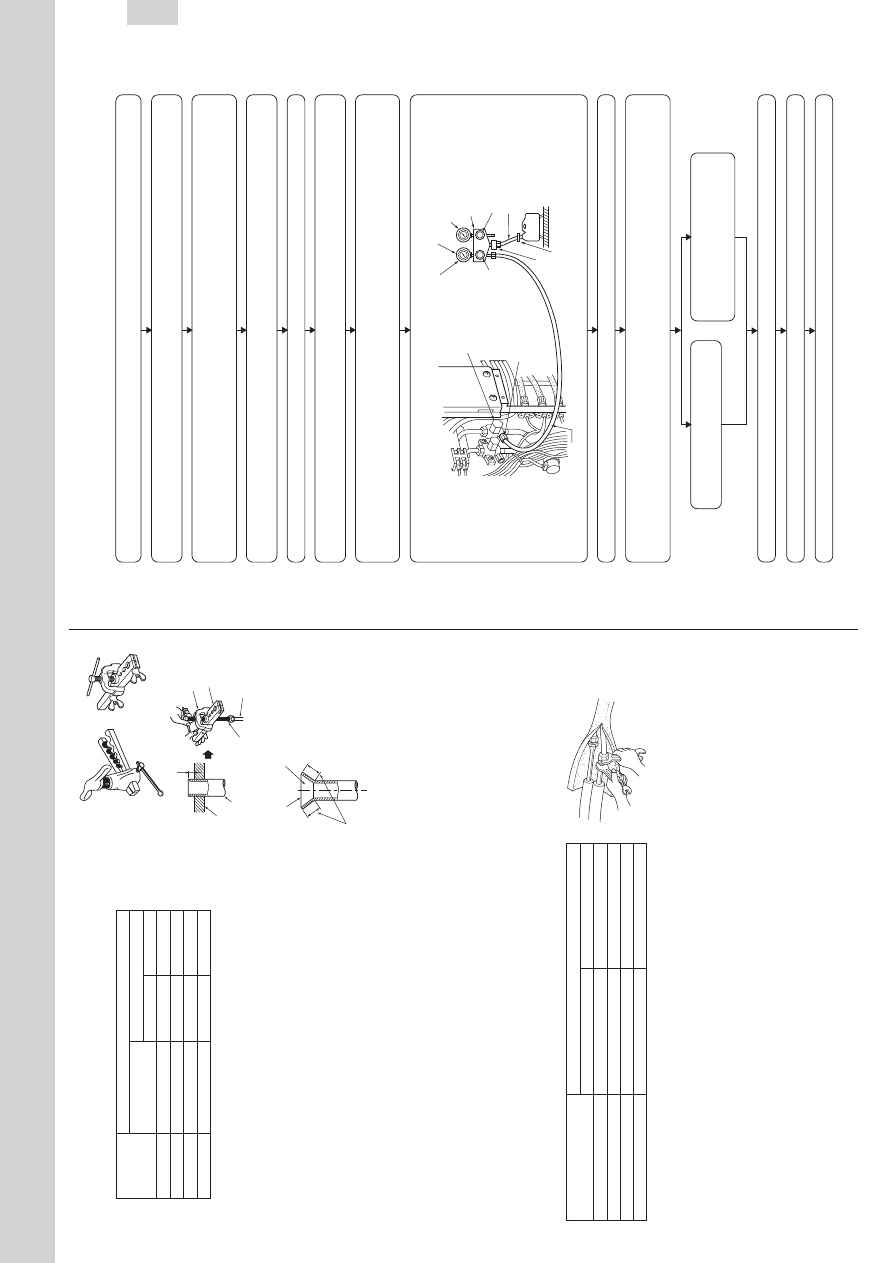
7
A
D
ie
Copper
pipe
Flare
nut
D
ie
Copper
pipe
Smooth
all
around
E
v
e
n
l
e
n
g
th
all
around
Inside
is
shining
without
any
scratches
Y
o
rk
4
.
F
la
ri
n
g
w
o
rk
•
P
e
rf
o
rm
f
la
ri
n
g
w
o
rk
u
s
in
g
f
la
ri
n
g
t
o
o
l a
s
s
h
o
w
n
in
t
h
e
r
ig
h
t.
A
(mm)
Outside
diameter
Flare
tool
for
R410A
Conventional
flare
tool
c
lu
tc
h
t
y
p
e
C
lu
tc
h
t
y
p
e
W
in
g
n
u
t
ty
p
e
ø
6.35 mm
0 to 0.5
1.0 to 1.5
1.5 to 2.0
ø
9.52 mm
0 to 0.5
1.0 to 1.5
1.5 to 2.0
ø
12.7 mm
0 to 0.5
1.0 to 1.5
2.0 to 2.5
ø
15.88
mm
0
to
0.5
1.0
to
1.5
—
Firmly
hold
copper
pipe
in
a
die
in
the
dimension
shown
in
the
ta
b
le
a
b
o
v
e
.
5
.
C
h
e
c
k
•
Compare
the
flared
work
with
the
figure
below
.
•
If
flare
is
noted
to
be
defective,
cut
of
f
the
flared
section
and
perform
flaring
work
again.
5-3
PIPE
CONNECTION
N
o
te
:
Fasten
a
flare
nut
with
a
torque
wrench
as
specified
in
the
table
below
.
When
fastened
too
tight,
a
flare
nut
may
be
broken
after
a
long
period
and
cause
a
leakage
of
refriger-
a
n
t.
1
.
In
d
o
o
r
u
n
it
c
o
n
n
e
c
ti
o
n
•
Connect
both
liquid
pipe
and
gas
pipe
to
indoor
unit.
-
Apply
a
thin
coat
of
refrigeration
oil
to
the
seat
surface
of
pipe.
-
F
o
r
c
o
n
n
e
c
ti
o
n
,
a
lig
n
t
h
e
c
e
n
te
r
o
f
b
o
th
p
ip
e
a
n
d
u
n
io
n
,
th
e
n
t
ig
h
te
n
t
h
e
f
ir
s
t
3
t
o
4
t
u
rn
s
in
f
la
re
n
u
t
b
y
h
a
n
d
.
-
For
tightening
the
union
part
of
the
indoor
unit
side,
use
the
table
below
as
a
standard
and
tighten
the
flare
nut
with
two
wrenches.
Excessive
tightening
damages
the
flared
section.
Pipe
diameter
Tightening
torque
N
·m
k
g
f·
c
m
ø
6.35
mm
13.7
to
17.7
140
to
180
ø
9.52
mm
34.3
to
41.2
350
to
420
ø
12.7
mm
49.0
to
56.4
500
to
575
ø
15.88
mm
73.5
to
78.4
750
to
800
2
.
O
u
td
o
o
r
u
n
it
c
o
n
n
e
c
ti
o
n
•
Connect
pipes
to
the
pipe
joint
part
of
the
stop
valve
in
the
same
method
as
the
indoor
unit.
-
For
tightening,
use
the
same
tightening
torque
applied
for
indoor
unit
and
tighten
the
flare
nut
with
torque
wrench
or
spanner
.
INSULA
TION
AND
T
APING
1
Cover
piping
joints
with
pipe
cover
.
2
For
outdoor
unit
side,
surely
insulate
every
piping
including
valves.
3
Using
piping
tape
E
,
apply
taping
starting
from
the
entry
of
outdoor
unit.
•
Fix
the
end
of
piping
tape
E
with
adhesive
tape.
•
When
piping
has
to
be
arranged
through
above
ceiling,
closet
or
area
where
the
temperature
and
humidity
are
high,
wind
additional
commercially
sold
insulation
for
prevention
of
condensation.
5-4
PURGING
PROCEDURES
•
LEAK
TEST
•
Perform
the
manifold
valve
work
securely
according
to
the
installation
manual
of
the
manifold
valve.
Flaring
tool
Wing
nut
type
Clutch
type
PURGING
PROCEDURES
Connect
the
refrigerant
pipes
(both
liquid
pipe
and
gas
pipe)
between
the
indoor
and
the
outdoor
unit.
Remove
the
service
port
cap
of
the
stop
valve
on
the
gas
pipe
side
of
the
outdoor
unit.
(The
stop
valve
will
not
work
in
it
initial
state
fresh
out
of
the
factory
[totally
closed
with
cap
on].)
Connect
the
gauge
manifold
valve
and
the
vacuum
pump
to
the
service
port
of
the
stop
valve
on
the
gas
pipe
side
of
the
outdoor
unit.
Run
the
vacuum
pump.
(V
acuumize
for
more
than
15
minutes.)
Check
the
vacuum
with
the
gauge
manifold
valve,
then
close
the
gauge
manifold
valve
and
stop
the
vacuum
pump.
Leave
it
as
is
for
one
or
two
minutes.
Make
sure
the
pointer
of
the
gauge
manifold
valve
remains
in
the
same
position.
Confirm
that
the
pressure
gauge
shows
–
0.101
MPa
[Gauge]
(–
760
mmHg).
Pipe
length
up
to
40
m
No
gas
charge
is
needed.
Pipe
length
exceeding
40
m
Charge
the
prescribed
amount of gas. (refer to 5-1)
Remove
the
gauge
manifold
valve
quickly
from
the
service
port
of
the
stop
valve.
After
refrigerant
pipes
are
connected
and
evacuated,
fully
open
all
stop
valves
on
both
sides
of
gas
pipe
and
liquid
pipe.
Operating
without
fully
opening
lowers
the
performance
and
this
causes
trouble.
T
ighten
the
cap
to
the
service
port
to
obtain
the
initial
status.
Retighten
the
cap.
Leak
test
(or
the
vacuum
pump
with
the
function
to
prevent
the
back
flow)
Gauge
manifold
valve
(for
R410A)
Pressure
gauge
(for
R410A)
Compound
pressure
gauge
(for
R410A)
-0
.1
0
1
M
P
a
(-760
mmHg)
H
a
n
d
le
L
o
w
Handle
High
W
in
d
o
w
Charge
hose
(for
R410A)
V
a
cu
u
m
p
u
m
p
Adapter
for
p
re
v
e
n
ti
n
g
the
back
flow
Charge
hose
(for
R410A)
Stop
valve
(gas
side)
Service
port
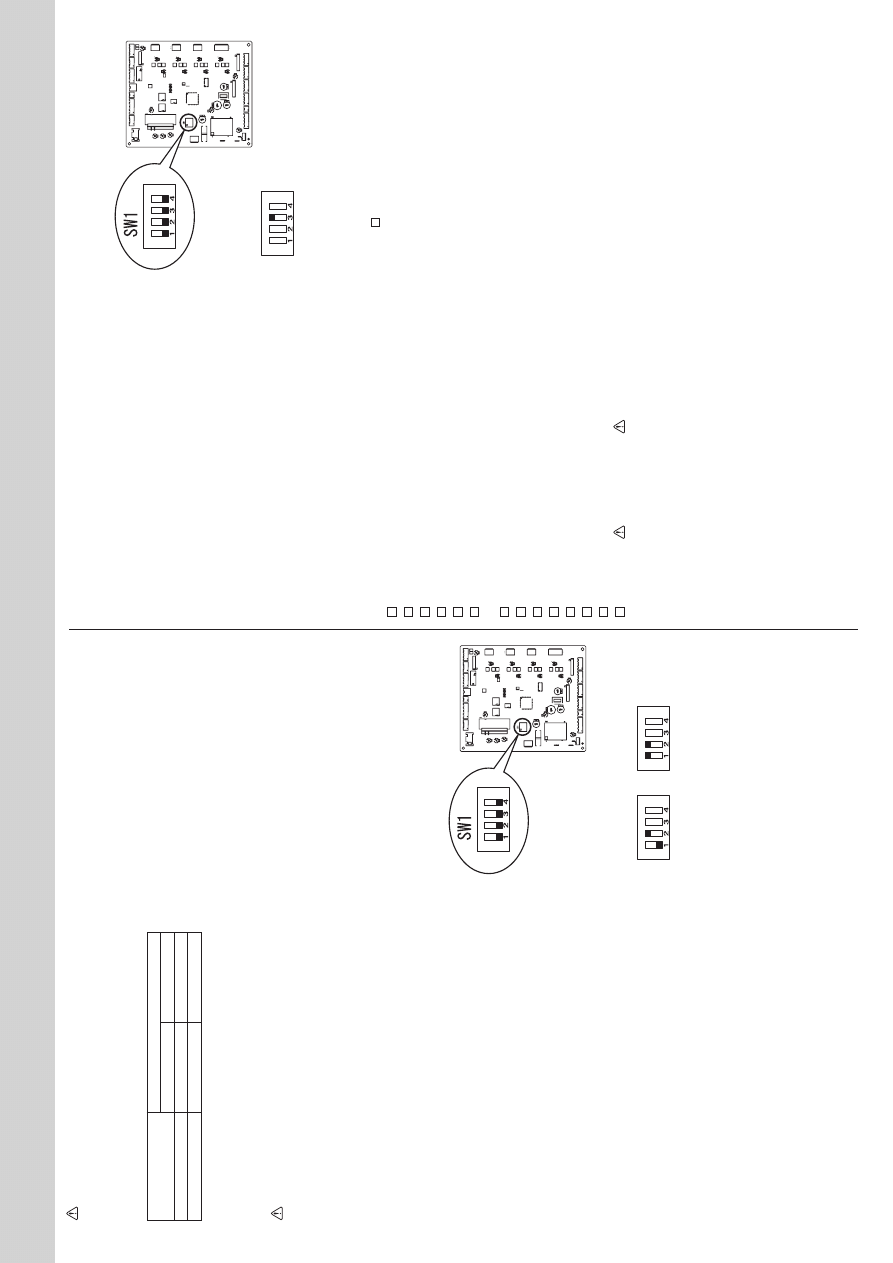
8
W
A
R
N
IN
G
:
When
installing
or
moving
the
unit,
do
not
mix
anything
other
than
specified
refrigerant
(R410A)
into
the
refrigerating
cycle.
If
air
is
mixed,
it
may
cause
the
refrigerating
cycle
to
get
abnormally
high
temperature,
causing
a
risk
of
b
u
rs
t.
T
ightening
torque
N
·m
k
g
f·
c
m
Cap
for
service
port
13.7
to
17.7
140
to
180
Cap for stop valve
19.6 to 29.4
200 to 300
5
-5
E
A
R
T
H
IN
G
W
O
R
K
Put
the
earth
circuit
to
the
ground
in
accordance
with
“T
echnical
Standards
for
Electrical
Installation
”.
CAUTION:
Do
not
connect
the
earth
cable
to
any
gas
pipe,
water
pipe,
lightening
rod
or
telephone
earth
cable.
If
there
is
some
deficiency
in
earthing
work,
it
may
cause
a
risk
of
electric
shock.
The
product
incorporates
a
frequency
inverter
and
so
requires
earthing
in
order
to
observe
electric
charge
and
noise
caused
by
static
electricity
.
5
-6
L
O
C
K
IN
G
T
H
E
O
P
E
R
A
T
IO
N
M
O
D
E
O
F
T
H
E
A
IR
C
O
N
D
IT
IO
N
E
R
(
C
O
O
L
,
DR
Y
,
HEA
T)
•
Description
of
the
function:
With
this
function,
you
can
lock
the
operation
mode
of
the
outdoor
unit.
Once
the
operation
mode
is
locked
to
either
COOL/DR
Y
mode
or
HEA
T
mode,
the
air
conditioner
oper-
ates
in
that
mode
only
.
*
Initial
setting
is
required
to
activate
this
function.
Please
ex-
plain
about
this
function
to
your
customers
and
ask
them
whether
they
want
to
use
it.
[How
to
lock
the
operation
mode]
1
B
e
s
u
re
t
o
t
u
rn
o
ff
t
h
e
m
a
in
p
o
w
e
r
fo
r
th
e
a
ir
c
o
n
d
it
io
n
e
r
before
making
the
setting.
2
Set
the
2nd
Dip
Switch
of
SW1
on
the
outdoor
controller
board
to
ON
to
enable
this
function.
3
T
o
lock
the
operation
mode
in
COOL/DR
Y
mode,
set
the
1st
Dip
Switch
of
SW1
on
the
outdoor
controller
board
to
OFF
.
T
o
lock
the
operation
in
HEA
T
mode,
set
the
same
switch
to
O
N
.
4
T
urn
on
the
main
power
for
the
air
conditioner
.
5-7
LOWERING
THE
OPERA
TING
NOISE
OF
THE
OUTDOOR
UNIT
•
Description
of
the
function:
With
this
function,
you
can
lower
the
operating
noise
of
the
outdoor
unit
when
the
operation
load
is
small,
for
example,
during
nighttime
in
COOL
mode.
However
,
please
note
that
the
cooling
and
heating
capacity
can
also
be
lowered
if
this
function
is
activated.
*
Initial
setting
is
required
to
activate
this
function.
Please
ex-
plain
about
this
function
to
your
customers
and
ask
them
whether
they
want
to
use
it.
[How
to
lower
the
operating
noise]
1
Be
sure
to
turn
of
f
the
main
power
for
the
air
conditioner
before
making
the
setting.
2
S
e
t t
h
e
3
rd
D
ip
S
w
itc
h
o
f S
W
1
o
n
th
e
o
u
td
o
o
r
c
o
n
tr
o
lle
r
b
o
a
rd
to
ON
to
enable
this
function.
3
T
urn
on
the
main
power
for
the
air
conditioner
.
5-8
CHECKING
AFTER
INST
ALLA
TION
After
finishing
the
installation,
check
the
following
items
again
by
marking
.
Have
special
circuits
been
provided?
Is
power
supply
voltage
as
specified?
Has
indoor/outdoor
connecting
wire
been
inserted
into
terminal
block?
Has
indoor/outdoor
connecting
wire
been
secured
firmly?
Has intermediary connection between power cable and indoor/outdoor connecting wire been carried out?
Is
combination
of
connection
pipes
and
indoor/outdoor
connecting
wire
correct
(Room
A,
Room
B,
Room
C,
Room
D)?
Is
earth
cable
connection
correct?
Has
leak
test
been
carried
out?
Has
air
purge
been
carried
out?
Is
stop
valve
fully
open?
Has
drain
discharge
been
checked?
Is
insulation
over
connection
pipe
joints
correct?
Is
strength
of
installation
location
well
enough?
Have
all
of
W
ARNING
and
CAUTION
items
in
“1.
THE
FOLLOWING
SHOULD
AL
W
A
YS
BE
OB-
SER
VED
FOR
SAFETY
”
been
checked?
C
O
O
L
/D
R
Y
H
E
A
T
O
N
O
N
O
N
O
N
O
N
Lower
the
operating
n
o
is
e
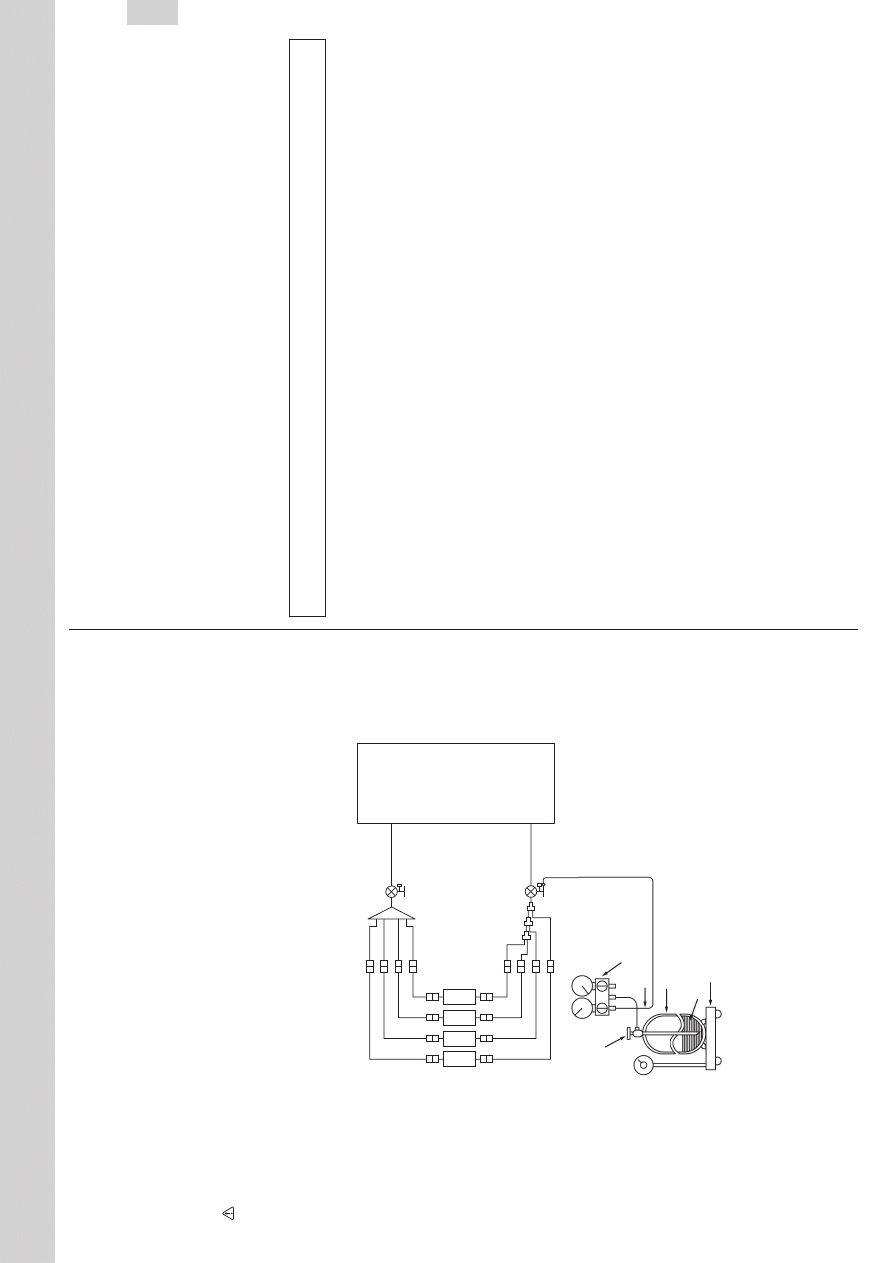
9
A
B
C
D
5-9
GAS
CHARGE
Perform
gas
charge
to
unit.
1
Connect
gas
cylinder
to
the
service
port
of
stop
valve.
2
Perform
air
purge
of
the
pipe
(or
hose)
coming
from
refrigerant
gas
cylinder
.
3
Replenish
specified
amount
of
the
refrigerant,
while
operating
the
air
conditioner
for
cooling.
N
o
te
:
In
case
of
adding
refrigerant,
comply
with
the
quantity
specified
for
the
refrigerating
cycle.
CAUTION:
When
charging
the
refrigerant
system
with
additional
refrigerant,
be
sure
to
use
liquid
refrigerant.
Add-
ing
gas
refrigerant
may
change
the
composition
of
the
refrigerant
in
the
system
and
affect
normal
operation
of
the
air
conditioner
.
Also,
charge
the
system
slowly
,
otherwise
the
compressor
will
be
lo
c
k
e
d
.
T
o
maintain
the
high
pressure
of
the
gas
cylinder
,
warm
the
gas
cylinder
with
warm
water
(under
40
°C)
during
cold
season.
But
never
use
naked
fire
or
steam.
In
d
o
o
r
u
n
it
U
n
io
n
Stop
valve
O
u
td
o
o
r
u
n
it
U
n
io
n
Gauge
manifold
valve
(for
R410A)
Charge
hose
(for
R410A)
Refrigerant
gas
c
y
lin
d
e
r
operating
valve
(for
R410A)
Refrigerant
gas
cylinder
for
R410A
with
siphon
Refrigerant
(liquid)
Electronic
scale
for
refrigerant
charging
Liquid
pipe
Gas
pipe
U
n
io
n
Stop
valve
with
service
port
U
n
io
n
5
-1
0
T
E
S
T
R
U
N
•
Be
sure
to
perform
the
test
run
for
each
unit.
Make
sure
each
indoor
unit
operates
properly
following
the
installation
manual
attached
to
the
unit.
•
If
you
perform
the
test
run
for
all
indoor
units
at
once,
you
cannot
detect
any
erroneous
connection,
if
any
,
of
the
refrigerant
pipes
and
the
indoor/outdoor
unit
connecting
wires.
About
the
restart
protective
mechanism
Once
the
compressor
stops,
the
restart
preventive
device
operates
so
the
compressor
will
not
operate
for
3
minutes
to
protect
the
air
conditioner
.
5
-1
1
E
X
P
L
A
N
A
T
IO
N
T
O
T
H
E
C
U
S
T
O
M
E
R
•
Recommend
the
customer
to
read
the
OPERA
TING
INSTRUCTIONS
carefully
.
•
Using
the
OPERA
TING
INSTRUCTIONS
for
each
unit,
explain
the
following
to
the
customer
,
how
to
control
temperature,
how
to
remove
the
air
filters,
how
to
remove
or
put
the
remote
controller
in
the
remote
controller
holder
,
how
to
clean,
precautions
for
operation,
etc.
If
the
customer
(user)
is
absent,
explain
to
the
purchaser
(owner
,
building
’s
controller
,
etc)
about
those
p
o
in
ts
.

1
0
Wyszukiwarka
Podobne podstrony:
IM MAC 399IF E SG79Y416H05 Sep 2009
IM MXZ 2A30 52VA SG79Y760H04 GB 04 2009
IM MAC 397IF E SG79Y415H01 EN
IM MXZ 8A140VA BG79U438H05 GB 11 2007
IM MSZ GA22 35 MUZ 25 35VA SG79Y421H01 GB Nov 2006
IM MSZ GA50 71VA SG79Y434H01 GB 07 2005
IM BG79U438H04 pl MXZ 8A140
IM BG79U438H04 MXZ 8A140
60 Rolle der Landeskunde im FSU
IM 5 dyfuzja wyklad 03
jadłospis, Turystyka i Rekreacja UW im. MSC, IV Semestr, Żywienie Człowieka
Problemy w małżeństwie i przeciwdziałanie im, konspekty, KONSPEKT, wych.do.życia, klasa II
praca-magisterska-7092, 1a, prace magisterskie Politechnika Krakowska im. Tadeusza Kościuszki
praca-magisterska-7091, 1a, prace magisterskie Politechnika Krakowska im. Tadeusza Kościuszki
NA kolosa Z IM
Uczelnia Warszawska im
Biogasanlagen im EEG 2009
Datenblaetter im Web
więcej podobnych podstron